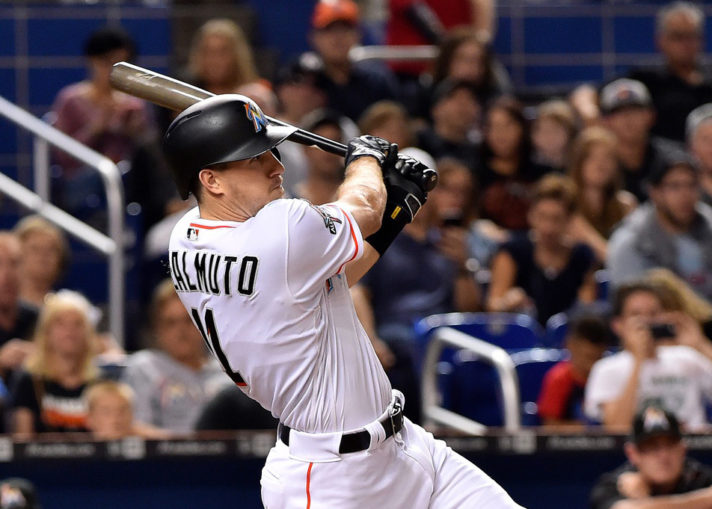
Give Brodie Van Wagenen credit—with just one fell swoop, he established the Mets as major players this offseason and bragged to continue.
Whether or not you disagree with the specifics of the Robinson Cano/Edwin Diaz trade, Van Wagenen at a bare minimum shook things up and tangibly improved the team for 2019. And yet, should the Mets make another such deal, one could argue that the swashbuckling Van Wagenen has taken his hyperactivity in the offseason a step too far while bringing the Mets a step backward—according to reports from SNY’s Andy Martino (and later confirmed by Jon Heyman), the Mets have discussed outfielders Brandon Nimmo and Michael Conforto in addition to shortstop Amed Rosario as possible chips in trading for Marlins catcher J.T. Realmuto.
According to Martino, if the Mets swung such a trade, the Mets would then sign free agent center fielder A.J. Pollock to replace Nimmo or Conforto.
Let us hypothesize that the Mets go through with what appears to be their intended course of action, that is, trade for Realmuto using a package of Nimmo or Conforto with additional prospects (as discussed by Martino), then signed A.J. Pollock, relegating Travis d’Arnaud to a backup role. Here are the Steamer projections for the involved players in this set of transactions:
| Player | BA | OBP | SLG | wRC+ | WAR/600 PA | Transaction |
|---|---|---|---|---|---|---|
| J.T. Realmuto | 0.267 | 0.322 | 0.435 | 108 | 4.0 | To Mets in trade |
| Travis d’Arnaud | 0.241 | 0.302 | 0.410 | 96 | 2.5 | To Mets bench |
| A.J. Pollock | 0.259 | 0.325 | 0.445 | 108 | 3.0 | To Mets in free agency |
| Brandon Nimmo | 0.239 | 0.352 | 0.396 | 112 | 2.3 | To Marlins |
By Steamer, the Mets essentially gain 2.2 WAR in these transactions—Realmuto is certainly an upgrade over d’Arnaud, and Realmuto’s health (Realmuto has played 120+ games every season since 2015—quite the feat for a catcher) relative to d’Arnaud could help compensate for Pollock’s well-known health issues. Still, Steamer may yet be underrating Nimmo, who had a breakout last season and was arguably the best hitter on the Mets—even if Nimmo’s power regresses, his prodigious talent for reaching base buoys his production at the plate should keep him productive at the plate. The Mets are wise to recognize that Nimmo’s stock is at its highest, but they should not ignore that Nimmo is still an extremely valuable asset even if his price falls, and he could yet buoy a team whose stated goal is to win in 2019.
Should the Mets try to package Conforto in this trade, I would encourage you all to riot in the streets: Conforto is perhaps the single best position player in Mets uniform today, and despite being slowed by injury in 2018, Conforto still hit at a rate 20 percent above league average while providing 3 fWAR. A healthier Conforto rebounded in the 2nd half of 2018, slashing .273/.356/.539, and baring catastrophic unforeseen circumstances, he should easily be the Mets’ best hitter in 2019. A championship-winning Mets team involves Conforto, simple as that, and trading him to get Realmuto would be taking a massive step backward from a 2018 team who struggled offensively.
And if the Mets want to trade Rosario (as the player that the Marlins are most keen on), they have no immediate means of replacing him or his future production. As Rosario stands currently, with no further development, he is essentially a 2 WAR shortstop—the Mets’ only real option in replacing him would be the unspectacular but solid Jose Iglesias. in free agency. Top prospect Andres Gimenez is still a ways away and might find the same growing pains that Rosario himself found in his debut season. And Rosario might still improve further, especially defensively! The Mets are right to be reluctant to trade Rosario because the available options represent sub-optimal usage of roster resources.
Still, a Nimmo + prospects for Realmuto trade doesn’t sound impressively awful, correct? Yet, the deal itself pales in comparison to what the Mets might otherwise do. Below are three catchers’ 2018 deserved stats and framing runs (the estimated number of runs saved by each catcher as a result of their ability to steal strikes), per Baseball Prospectus. All three catchers can bat from the right side, all three have relatively solid health histories, and all three are available in some form—can you guess who each is?
| Player | dBA | dOBP | dSLG | dOPS | Framing Runs |
|---|---|---|---|---|---|
| Player A | 0.242 | 0.344 | 0.449 | 0.793 | 15.7 |
| Player B | 0.269 | 0.333 | 0.458 | 0.790 | -0.4 |
| Player C | 0.276 | 0.336 | 0.449 | 0.784 | 0.3 |
Player B is the current object of the Mets’ affection, Realmuto—Realmuto has usually fared well with framing metrics, but Baseball Prospectus’ 2018 metrics indicated that Realmuto took a step backward (something that Baseball Savant might disagree with—Realmuto ranked 3rd in stolen strikes-lost strikes in 2018), but was otherwise about as good as Player A and Player C with the bat.
Player C is Wilson Ramos, of whom the Mets have also expressed an interest in. To be sure, Ramos is an inferior option defensively and has graded out as such for much of his career. With only a negligible difference between Ramos and Realmuto defensively and offensively, Realmuto’s history and youth give him an edge over Ramos—but Ramos is available on the free agent market, and Ramos’ cost has likely gone down considerably as some teams in major need of catching, such as the Astros and Nationals, have already filled those slots.
Player A is Yasmani Grandal, who I have highlighted as a major free agency target for the Mets for this offseason on MMO previously. Grandal is a switch hitter who is not a liability from the right-handed side of the plate (.728 OPS career as an RHB), but most importantly, Grandal is perhaps the best pitch framer in the major leagues, full stop.
According to both Baseball Prospectus and Baseball Savant, no full-time catcher was better last season at stealing strikes, and Grandal has consistently profiled as a top-tier pitch framing throughout his career. To be fair, Realmuto has profiled as better with regards to limiting stealing bases, but in their careers, Realmuto has thrown out just 33% of runners on attempts, whereas Grandal has thrown out 26%—the difference is just a couple of bases over the course of a season, and there’s only so much a catcher like Realmuto might be able to do with the Mets’ slow-to-the-plate staff. Grandal is as good of an option as Realmuto if not better.

If the Mets go through in trading Nimmo or Pollock for Realmuto for Pollock, they’ll be at the mercy of Pollock’s price-tag: as the only true center fielder on the market is Pollock, aside from the declining Adam Jones, Pollock signing somewhere else would leave the Mets devastated and with a major hole in the outfield.
While FanGraph’s crowd-sourced contracts pegged Pollock as deserving of a 4-year, $64 million contract, Pollock is reportedly seeking an even bigger deal, in the range of Lorenzo Cain‘s 5 year/$80 million contract with the Brewers—while not bringing to the table Cain’s health history, that Pollock is far-and-away the best CF option on the FA market means that Pollock has considerable leverage in asking for a larger deal.
But the Mets would see their best improvement in signing Grandal to a contract—Grandal was projected to sign for 3-years, $45 million by FanGraphs, and given that a number of landing spots for Grandal have been eliminated and the fact that the catching market is considerably deeper than the centerfield market, Grandal might still yet cost less than signing Pollock. Ramos, who would provide a similar impact as Grandal with his bat if not with his glove, would be even cheaper. Both Grandal and Ramos would represent 2-3 WAR improvements over the current roster, for cheaper than Pollock and without having to give up a stud outfielder and additional prospects.
Given Pollock’s injury history and age, trading Nimmo or Conforto for Realmuto and signing Pollock would, in all likelihood, simply make the team worse, more expensive, and more injury-prone than if the Mets had signed a catcher of Realmuto’s caliber on the free agency market. That is to say nothing of what might happen should the Mets trade Nimmo or Conforto and fail to sign Pollock.
This is where malpractice comes in—the Mets should not abandon one of their breakout stars and one of their best bats, let alone their improving shortstop, just to make the team worse overall. Given that the Mets still hope to make further splashes on the free agency market this season while intending to compete, making sub-optimal moves such as these represent major missed opportunities, and are easily condemnable.















